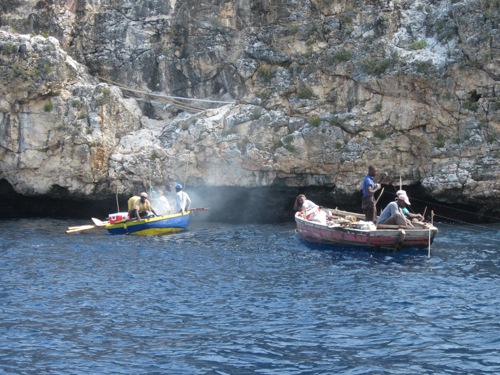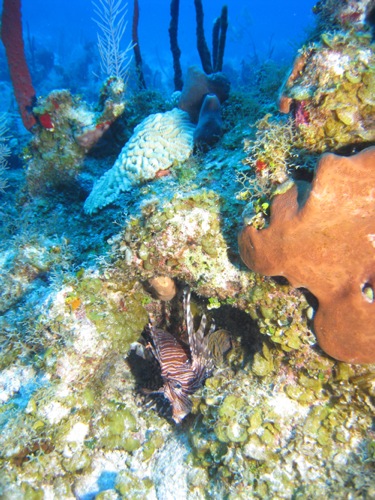Throughout this week, students from two high schools—Gig Harbor High School in Gig Harbor, Washington and Corona del Sol High School in Tempe, Arizona—have been virtually following the Global Reef Expedition to learn more about the work of the Living Oceans Foundation. Recruited through the Coral Reef Educator on the Water (CREW) Program, the schools represent entirely different environments from that of Navassa. They recently had an opportunity to submit questions to Navassa Mission researchers.

Gig Harbor High School, Gig Harbor, WA
Q. Considering the current state of the reefs, what will Navassa’s reefs and fishes look like in 20 years?
A. The reefs surrounding Navassa lost a lot of their coral between 2004-2006 from coral bleaching and coral disease. Since this time, conditions have been much more stable and corals are doing better. There are few signs of disease during this survey. Coral cover has increased, and many of the older, massive corals that were affected by bleaching and disease only partially died. These are beginning to grow back over their old skeletons. These reefs could continue to rebound, unless global stressors associated with climate change get worse. However, given the changes seen throughout the Caribbean, it appears that reefs are undergoing a shift in dominant species away from some of the longer lived massive corals (e.g. star coral), with a replacement by lettuce coral (Agaricia) and mustard hill coral (Porites astreoides). Twenty years from now there could be relatively good coral cover, dominated by these two taxa, with small colonies of star coral, brain corals, and other species. – Andy Bruckner, Living Oceans Foundation.
Q. What type of fishing is common around Navassa?
A. The Haitian fishermen generally use the Caribbean Z Trap made out of bamboo, hand-lines, and less often now (thankfully), nets. – Jean Wiener, Foundation for the Protection of Marine Biodiversity.

Q. Are there any invasive species other than the lionfish?
A. Tubastrea, an invasive species of coral, has been observed on Navassa. The species is found on the sides of the island and in cryptic habitats on the patch reefs near the island and feeds on passing zooplankton rather than relying on zooxanthellae for photosynthesis. On the island there are some domesticated animals that have been introduced by humans in the past. They include rats, cats, dogs, and goats. – Dana Williams, University of Miami.
Q. What is the education background of the researchers?
A. The background of the scientists on-board varies. Almost all the scientists have at least a Masters degree and the majority of scientists have a PhD. Most of the scientists got their degrees in fisheries and/or biology, but this varies. For example, I have two degrees in geology and one in marine studies. There are others with degrees in environmental science, marine science, sociology, and coastal zone management. While there is a wide range in degrees, most fall under the category of natural sciences. – Brian Beck, Living Oceans Foundation.
Corona del Sol High School, Tempe, AZ
Q. If you’ve already taken a fish count, do you compare them to previous records of fish species? If so, are any fish species missing in this count? What fish are left?
A. If there have been previous fish surveys conducted at our dive site, then our surveys are compared to those previous surveys. There are several methods to do a fish survey so it’s best to compare present surveys with previous ones that have used the same data collection methods. Previously, more jacks have been reported here, but so far we have only seen one species of jacks. Parrotfish, damselfish, surgeonfish, triggerfish, chromis, and wrasses are the most common fish here. Because of the fishing pressure, only a few grouper and snapper have been seen. – Dave Grenda, Florida Aquarium.
Q. How does the structure of the island affect the formation of the reefs?
A. Morphology of the Acropora palmata (elkhorn coral) perfectly illustrates your question. Typically, elkhorn looks like trees underwater, with a trunk and many branches fanning up and outwards and is found in shallow waters. On Navassa, because of its steep, wall-like shores, about 95% the elkhorn coral grows like moss on the sides of the walls. This species of coral has adapted perfectly to the steep structure of Navassa. – Jeremiah Blondeau, NOAA-Southeast Fisheries Science Center.
Q. Does anyone’s research involve doing anything to help the animal life on the island itself?
A. Yes, Navassa is a remote island, difficult to access, and dangerous to work on. Support from the Living Oceans Foundation allows Island Conservation to work intimately with local fishermen, photograph the island, and observe species and their interactions. We plan to protect the island’s biodiversity by preventing extinctions of the native, island-endemic species that call Navassa home. Navassa was previously home to eight endemic reptile species; four are now considered extinct. We hope to prevent any further extinctions by protecting Navassa’s geckos, anoles, galliwasps, seabirds, and native plants including an endemic palm as there is only one known individual remaining! Having coral reef scientists and other ecologists interacting with the island provides another perspective of the ecosystem as a whole. – Aurora Alifano, Island Conservation.
Q. What activity has affected Navassa’s coral population the most?
A. The only direct human disturbance in Navassa these days is artisanal fishing. We understand that fishing can have indirect effects on coral by altering the balance of food webs in coral reef system. However, the direct effects that we have observed affecting Navassa’s corals are disease and bleaching events, which are likely driven by wider changes in the ocean (e.g., warming) rather than direct local activities. – Margaret W. Miller, NOAA-Southeast Fisheries Science Center.

Q. Are parrotfish harmful or helpful to coral reefs? Are there any species that are particularly harmful to the reef?
Parrotfish are helpful and play a vital role in coral reef ecology. Parrotfish species, among others, are responsible for keeping algal growth to a minimum. No parrotfish = more algal growth = less recruitment space for coral = less corals. – Jeremiah Blondeau, NOAA-Southeast Fisheries Science Center.
Q. If you had to describe the biodiversity in 5 words, what words would you use?
Atypical. A lack of nursery habitat, plus a lot of vertical walls, means there are few snappers and groupers in the fish community.
Sparse. In part because of the isolation, there are fewer species in general than in some other parts of the Caribbean.
Hopeful. Diseases, bleaching, hurricanes, and other stressors have hit Navassa pretty hard in the past, but the coral species we’ve seen are doing pretty well. It is good to see a few long-spined sea urchins (Diadema). However, many more are needed to manage the high levels of macroalgae on the reef.
Special. Threatened elkhorn corals appear really healthy here.
Non-natural. Lionfish (an invasive species) are common and very large and there are also many non-native terrestrial species on the island itself. A staff member from Island Conservation is here with us to consider whether Navassa could be a candidate site for a project to remove non-native species and restore native endemic species.
– Greg Piniak, National Oceanic and Atmospheric Administration.

(Photos/Images by: 1-3 Eddie Gonzalez, 4 NOAA)
To follow along and see more photos, please visit us on Facebook! You can also follow the expedition on our Global Reef Expedition page, where there is more information about our research and our team members.